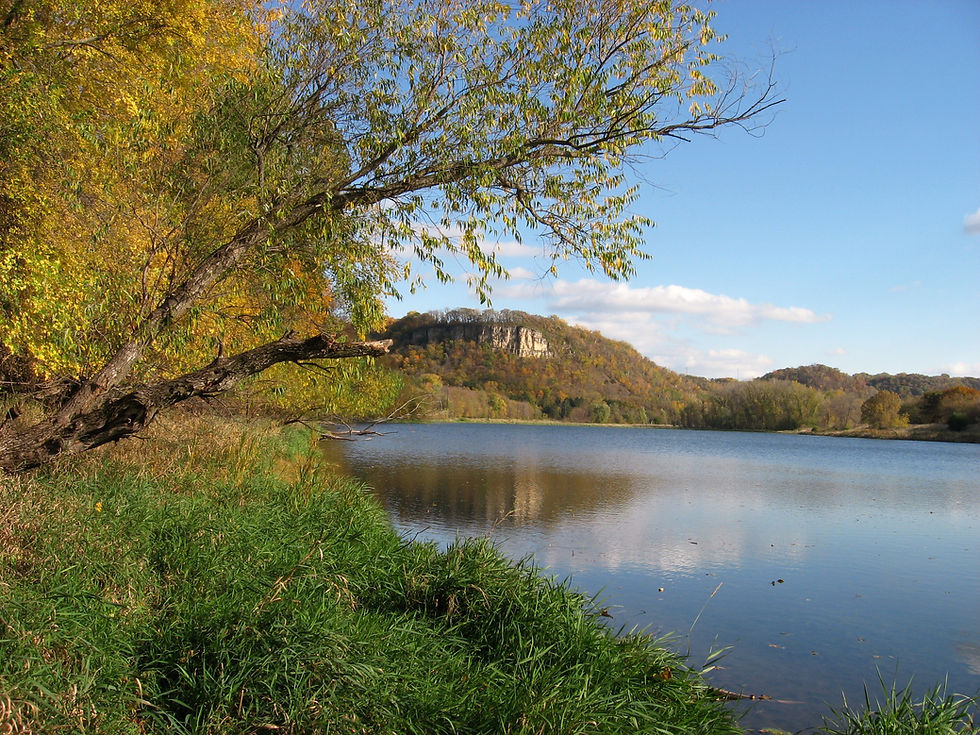Winter Solstice In Wacouta
- wacoutanaturenotes
- Jan 3
- 3 min read
Winter in all it's beauty finally arrived on December 17th with 5 inches of fresh snow. Unfortunately in the stark reality of climate change, our landscape returned to drab fall colors ten days later with 24 hours of rain and temperatures in the mid 40's.

On December 17th, we were blessed with more snow than we have received in the past 2 years. Tufts of fresh snow on top of the tall dried foliage transformed the prairie into a beautiful wonderland.
In recent weeks, we have been observing a relatively new arrival taking advantage of the welcoming habitat. The northern harrier (sometimes referred to as a marsh hawk) is a slender and buoyant hawk with an owl-like facial disk. An easy identification feature is the of a white rump. Harriers are most often seen flying low over the prairie in their attempt to capture small birds and mammals with a single pounce.

Our coldest morning of the season arrived in the early morning of December 21st the astronomical beginning of winter known as the solstice. Just before sunrise at 7:48 am, our thermometer registered a cold minus 9 degrees. With the sun at a low angle, the bright colors last just a couple of minutes.

The minus 9 degree temperature along with water vapor left over from the recent snowstorm resulted in spectacular hoarfrost. With the lack of wind during the night, ice crystals grew on tree branches and nearby vegetation.

With optimal snow conditions now available, I decided to get my cross country skis out of storage and go for a short tour. It was to be the first for the season and started from Wacouta road below the Town Hall.
I skied along the edge of the north side of Wacouta Pond down to the base of Rattlesnake Bluff. Surprisingly the conditions were ideal.

As I was skiing near the base of the bluff, I came across a deer carcass or what was left of it. I'm guessing it might have been wounded and not recovered during the deer hunt in Frontenac State Park in mid-November. The flesh had been completely eaten away from the bones.
All around the carcass were tracks in the fresh snow of coyotes, bald eagles and crows.

After completing my 2 mile ski tour, I returned home to take part in the Audubon Annual Christmas Bird Count that was started in the winter of 1900. It's purpose is to take a count in specific areas at relatively the same time for year to year comparisons.
The White-breasted Nuthatch featured in this photo is frequently observed moving headfirst down the trunk of a tree. This allows them to see insects other birds might have missed. Their name comes from a tendency to wedge nuts into the bark on a tree and then hatching the insides with their sharp beak.

The highest number Kathy and I observed for any one species was 20
for the American Goldfinch 20
Here is the count for the rest of the birds:
Northern Cardinal 2
Dark-eyed Junco 19
Downy Woodpecker 6
Tufted Titmouse 2
Hairy Woodpecker 1
Pileated Woodpecker 1
Red-bellied Woodpecker 1
Black-Capped Chickadee 4
House Finch 5
Blue Jay 2
European Starling 1
American Crow 4

One of my favorite winter birds is the Black-capped Chickadee. If I work hard enough, I can get them to feed out of my hand.

We have a pair of pileated woodpeckers that check our suet feeder several times a day. Their first appearance is usually a few minutes before or after 8:00 am.
This male pileated is sharing the feeder with a much smaller downy woodpecker. One of their more interesting traits is how they approach the feeder. They almost always come in and land near the top of our large cottonwood tree. From there they climb down the tree backwards.
Just before Christmas our neighbor Sue Milbright forwarded a most unusual
nature event near their house. They had trapped a white-footed deer mouse
and put it on the sidewalk to observe what animal might be interested in a meal.
They were amazed to see the first customer was a blue jay. It is well known
jays will kill baby birds in a nest in the spring. But a deer mouse???




Comments